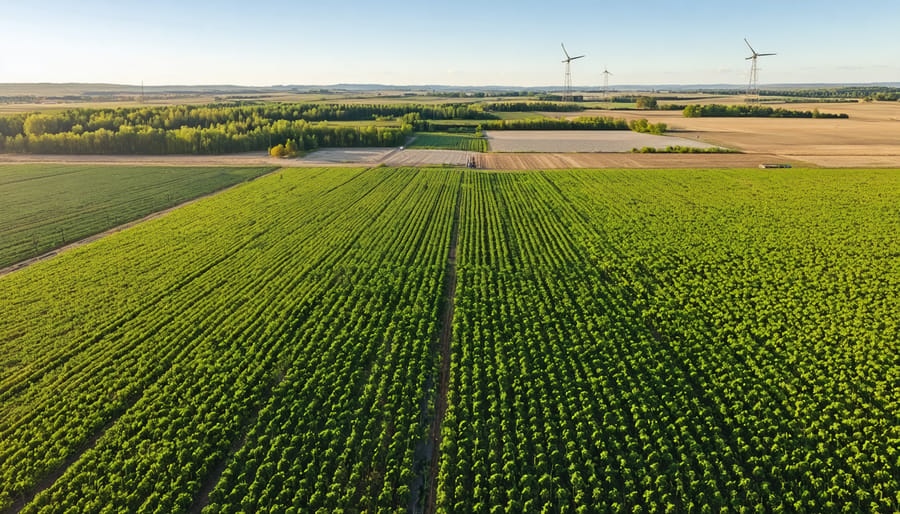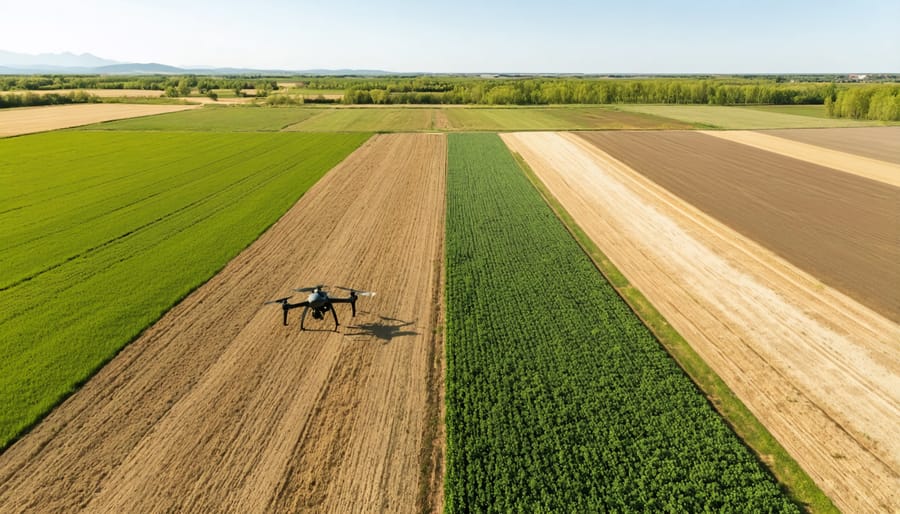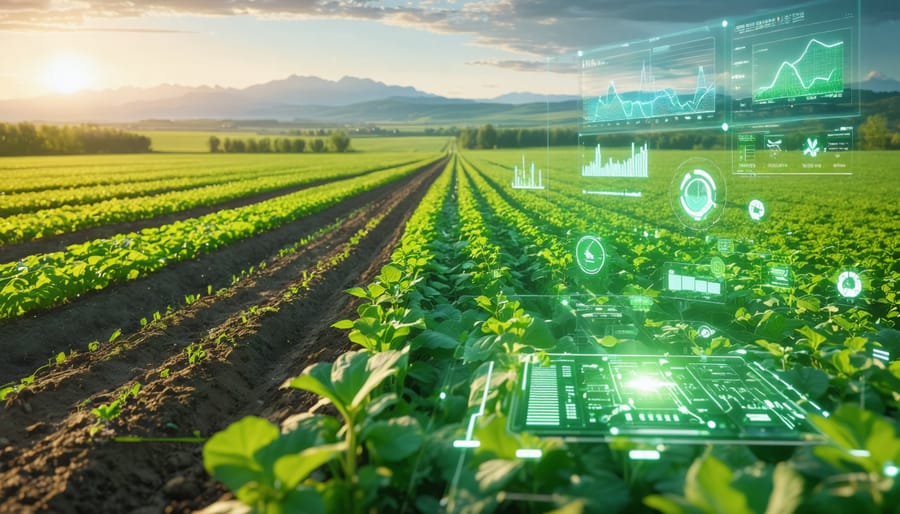Monitor soil health like a seasoned agronomist by measuring three critical indicators: microbial activity through CO2 respiration tests, aggregate stability using the wet sieve method, and organic matter content through loss-on-ignition analysis. These foundational metrics are now revolutionizing organic precision agriculture across Alberta’s diverse growing regions.
Deploy in-field sensors strategically at 15-30 cm depths to track moisture levels, pH, and electrical conductivity in real-time, enabling immediate response to changing soil conditions. Modern soil monitoring integrates traditional knowledge with digital innovation, empowering farmers to make data-driven decisions while maintaining their connection to the land.
Establish benchmark values by conducting comprehensive soil tests during key growth stages – pre-seeding, mid-season, and post-harvest. This systematic approach, paired with regular visual assessments of soil structure and plant health, creates a robust monitoring framework that serves both immediate operational needs and long-term soil stewardship goals.
The Building Blocks of Healthy Soil
Physical Indicators
Physical indicators serve as the foundation for assessing soil health in Alberta fields. The most visible sign is soil structure, which you can evaluate by examining soil aggregates – those small clumps that should crumble easily in your hands. Well-structured soil forms distinct blocks with clear edges and plenty of pore spaces for root growth and water movement.
Soil compaction, a common concern for Prairie farmers, can be measured using a penetrometer or even a simple wire flag pushed into the ground. Ideally, you should be able to push your finger into moist topsoil with moderate pressure. Water retention capacity, crucial during our dry spells, can be assessed by observing how quickly water infiltrates and how long moisture remains after rainfall. A healthy soil should feel like a wrung-out sponge when squeezed.
Regular monitoring of these physical indicators, especially after spring thaw and before seeding, helps track your soil’s health over time.
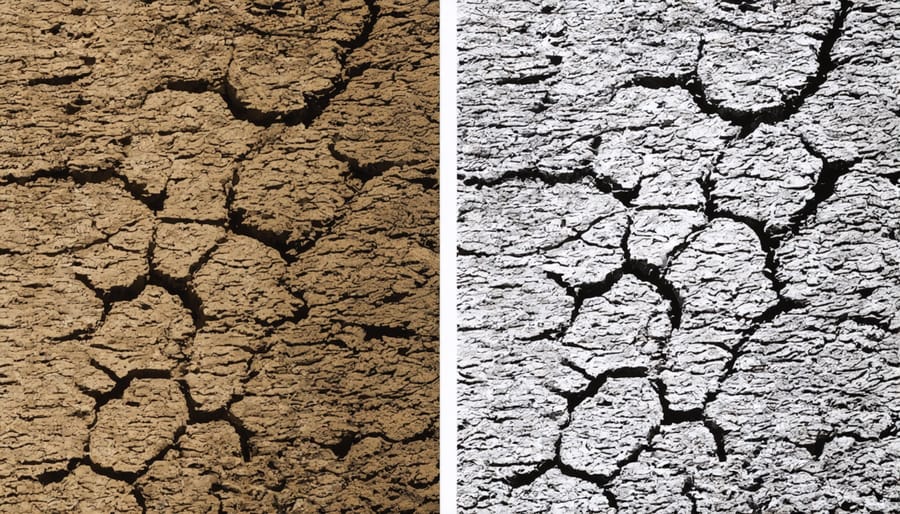
Biological Indicators
Biological indicators serve as vital signs of your soil’s living ecosystem. Measuring microbial activity through respiration tests can reveal how actively beneficial organisms are working to revitalize your soil. Here in Alberta, organic matter levels typically range from 2-6%, with higher percentages indicating better soil health. Regular earthworm counts provide a visual gauge of soil biodiversity – finding 8-10 worms per square foot suggests a thriving ecosystem. Monitoring these biological markers helps track your soil’s progress and guides management decisions. Consider partnering with local soil testing labs that offer comprehensive biological assessments, including microorganism diversity and enzymatic activity measurements, to get a complete picture of your soil’s living components.
Chemical Indicators
Chemical indicators provide vital insights into your soil’s overall health and fertility. pH levels, typically ideal between 6.0 and 7.5 for most crops in Alberta, influence nutrient availability and microbial activity. Regular testing of macronutrients (nitrogen, phosphorus, and potassium) and micronutrients helps ensure optimal growing conditions.
Local soil testing labs can analyze your samples for mineral content, including calcium, magnesium, and sulfur levels. Many Alberta farmers find success with seasonal testing, particularly in spring before planting and fall after harvest. Consider tracking organic matter content as well, as it affects nutrient retention and soil structure.
For best results, collect soil samples from multiple locations and depths in your field, creating a composite sample that represents your land’s overall condition. Remember that chemical indicators work hand-in-hand with physical and biological measurements to paint a complete picture of soil health.
Modern Monitoring Tools for Canadian Fields
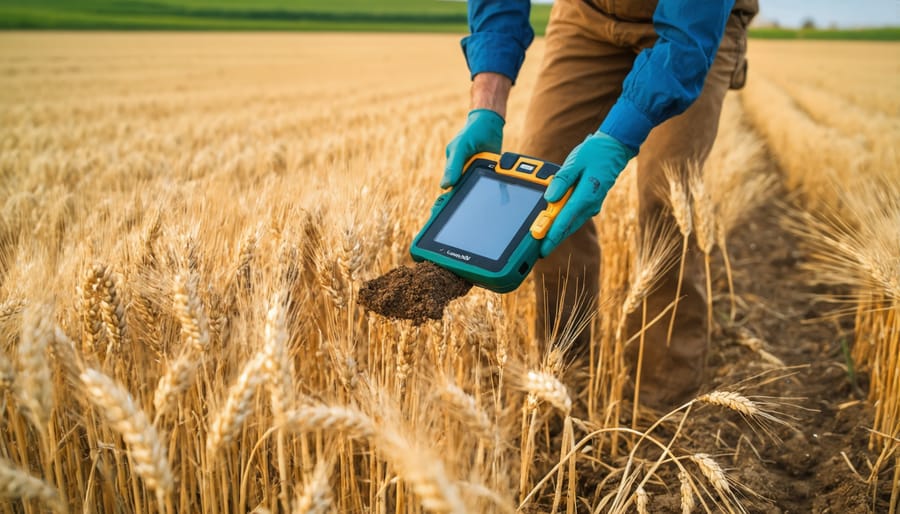
In-Field Testing Equipment
Modern in-field testing equipment has revolutionized how we monitor soil health right on the farm. Hand-held pH meters, soil moisture probes, and electrical conductivity sensors now allow farmers to get instant readings without sending samples to a lab. These portable tools are particularly valuable during Alberta’s short growing season when quick decisions can make all the difference.
A basic soil testing kit should include a penetrometer for measuring compaction, a digital pH meter, and a soil moisture sensor. Many Alberta farmers have found success with multi-parameter probes that can test several indicators at once, saving both time and effort during busy periods.
Newer technologies like spectral sensors can measure organic matter content and nutrient levels directly in the field. While these tools require a larger initial investment, many farming communities are setting up equipment-sharing programs to make them more accessible.
Temperature probes are especially useful in our climate, helping track soil warming in spring and cooling in fall. Some farmers pair these with smartphone apps that log data over time, creating valuable records for year-over-year comparison.
For those just starting with in-field testing, local agricultural extension offices often loan out basic equipment and provide training on proper use. Remember that while these tools are convenient, they should complement rather than replace regular laboratory testing for a complete understanding of your soil’s health.
Digital Soil Mapping
Modern digital soil mapping technologies have revolutionized how Alberta farmers understand and manage their soil health. Using GPS-enabled devices and sophisticated sensors, farmers can now create detailed maps of their fields that show variations in soil properties across different areas. These precision agriculture tools help identify specific zones that may need different management approaches.
A key advancement in this field is zone soil sampling, which combines GPS technology with traditional soil testing methods to create accurate, location-specific soil health assessments. This approach helps farmers make more informed decisions about irrigation, fertilization, and crop rotation strategies.
Remote sensing technologies, including satellite imagery and drone-mounted sensors, provide additional layers of information about soil moisture, organic matter content, and nutrient levels. Many Alberta farmers are now using these tools to track changes in their soil health throughout the growing season.
The data collected through digital mapping can be integrated with farm management software, allowing farmers to create detailed records and track improvements over time. This technology is particularly valuable in our prairie provinces, where soil conditions can vary significantly across large agricultural operations.
Local agricultural extension services offer training programs to help farmers implement these technologies effectively, ensuring that the investment in digital mapping tools translates into practical benefits for soil health management.
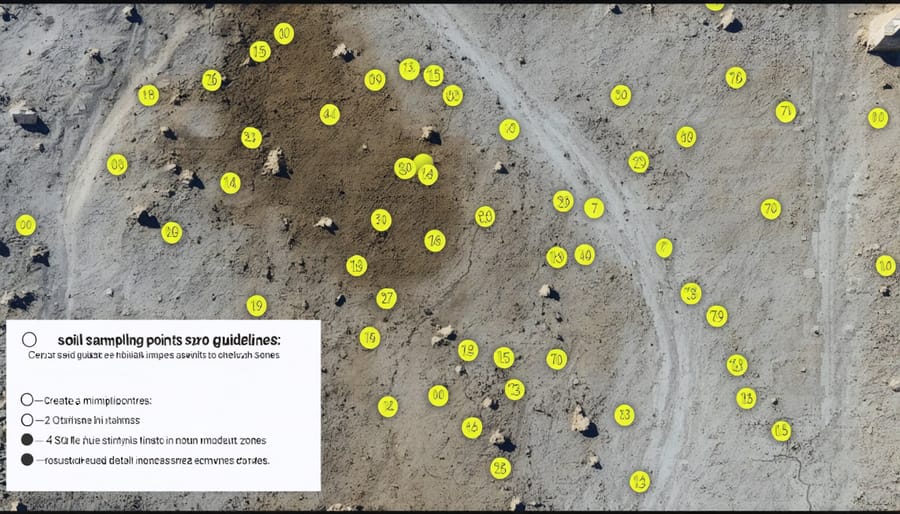
Laboratory Analysis Options
Alberta farmers have access to several accredited soil testing laboratories that provide comprehensive analysis services. The Alberta Agriculture and Forestry’s Soil and Crop Diagnostic Centre in Edmonton offers detailed soil nutrient analysis, while private labs like Down to Earth Labs in Lethbridge and A&L Canada Laboratories provide specialized testing packages tailored to agricultural needs.
These labs typically offer basic soil fertility packages that assess macronutrients (N, P, K), pH levels, and organic matter content. More comprehensive tests can include micronutrient analysis, soil texture assessment, and biological activity measurements. For organic farmers, specialized biological testing options are available to evaluate soil microbial populations and mycorrhizal colonization rates.
Most laboratories in Alberta provide sampling kits with detailed instructions for proper soil collection. Results usually arrive within 5-10 business days, accompanied by professional interpretations and specific recommendations for soil management. Many labs also offer seasonal testing packages that align with key growing periods in Alberta’s agricultural calendar.
Costs vary depending on the complexity of analysis, ranging from $50-$200 per sample for standard tests. Several agricultural associations and producer groups in Alberta offer member discounts for soil testing services. For the most accurate results, it’s recommended to conduct comprehensive soil tests every 2-3 years, with more frequent basic testing as needed for specific crop management decisions.
Real Results from Alberta Farms
Success Story: Red Deer Valley Farm
Located just outside of Red Deer, Alberta, the Thompson family’s organic farm stands as a testament to the power of strategic soil monitoring. Over the past five years, their 640-hectare operation has transformed from struggling with inconsistent yields to becoming a model of sustainable agriculture in central Alberta.
Sarah Thompson, a third-generation farmer, implemented a comprehensive soil monitoring program in 2018 after attending a local agricultural workshop. “We knew our soil needed attention, but we didn’t have the data to make informed decisions,” she explains. By incorporating regular soil testing, moisture sensors, and biological activity assessments, the farm has managed to boost soil health and reduce emissions while increasing productivity.
The results speak for themselves. Within three years, their wheat yields increased by 23%, while fertilizer costs decreased by 30%. The farm’s soil organic matter content improved from 2.8% to 4.2%, significantly enhancing water retention and nutrient availability.
Key to their success was the implementation of a seasonal monitoring schedule, with soil tests conducted every spring and fall. The Thompsons also invested in portable soil moisture probes, allowing them to make real-time irrigation decisions. They now share their monitoring protocols with neighboring farms, fostering a community-driven approach to soil health management in the Red Deer Valley region.
Cost-Benefit Analysis
When evaluating soil health monitoring investments, Alberta farmers typically see returns within 2-3 growing seasons. Initial costs for basic monitoring equipment, including pH meters and soil probes, range from $500 to $2,000, while comprehensive soil testing services average $150-300 per field annually.
The benefits often outweigh these costs significantly. Farmers implementing regular soil monitoring report 15-25% reductions in fertilizer use through more precise application, translating to savings of $40-60 per hectare. Enhanced soil management has also shown yield increases of 8-12% in common Prairie crops like canola and wheat.
Local farmer Dave Thompson from Lacombe County shares, “Our initial $1,800 investment in monitoring equipment paid for itself within 18 months through reduced input costs and better crop performance.” Similarly, a study by the Alberta Soil Health Coalition found that farms utilizing regular soil monitoring saw an average return on investment of 300% over five years.
Beyond direct financial benefits, soil monitoring helps prevent long-term issues that could cost thousands to remediate. Regular monitoring can identify potential problems like soil compaction or nutrient deficiencies before they impact yield, saving an estimated $200-400 per hectare in potential losses.
For those starting out, consider partnering with neighbouring farms to share equipment costs or accessing soil testing services through local agricultural extension offices, which often offer subsidized rates for first-time participants.
Seasonal Monitoring Schedule
A well-structured soil monitoring schedule is essential for maintaining healthy soil throughout Alberta’s growing season. Starting in early spring, typically mid-March to early April, conduct your first comprehensive soil test as soon as the ground thaws. This baseline assessment helps determine your soil’s readiness for the upcoming season and guides your fertility management decisions.
During spring planting (late April to May), focus on monitoring soil temperature and moisture levels daily. These measurements are crucial for optimal seed germination and early crop development. Use a soil thermometer at both 5 cm and 10 cm depths, aiming for temperatures above 10°C for most crops.
Throughout the main growing season (June to August), implement a bi-weekly monitoring routine that includes visual soil assessments and basic infiltration tests. After significant rainfall events, check for soil crusting and conduct quick spade tests to evaluate soil structure and root development. Mid-season tissue testing in late June or early July can help fine-tune your nutrient management strategy.
Late summer (August) is ideal for conducting biological activity assessments, such as earthworm counts and decomposition tests. These indicators are most active during this period and provide valuable insights into your soil’s health. Consider taking photos of soil profiles to track changes over time.
Post-harvest monitoring (September to October) should include another comprehensive soil test to evaluate nutrient levels and pH changes. This timing allows for fall amendments if needed and helps plan for the following season. Document crop residue decomposition rates and soil coverage before winter.
During the winter months (November to February), focus on analyzing your collected data and planning next season’s monitoring strategy. Use this time to calibrate equipment, replenish testing supplies, and review your soil health goals with fellow farmers or local agronomists.
Remember to adjust this schedule based on your specific location in Alberta and local weather patterns. Many successful farmers in our region maintain detailed monitoring logs, which prove invaluable for tracking long-term soil health trends and making informed management decisions.
As we’ve explored throughout this guide, maintaining healthy soil is fundamental to sustainable farming success in Alberta and across Canada. Regular soil health monitoring isn’t just about collecting data – it’s about making informed decisions that benefit both your farm’s productivity and its long-term sustainability.
Remember to start small and build your monitoring program gradually. Begin with basic tests like soil organic matter content and pH levels, then expand to more comprehensive assessments as you become comfortable with the process. Many local agricultural extension offices and soil testing facilities are ready to support your journey with expert guidance and resources.
Consider joining or forming a local soil health monitoring group with neighbouring farmers. Sharing experiences, equipment, and knowledge can make the implementation process more manageable and cost-effective. The collective insights gained from different farming operations can be invaluable for improving practices across our agricultural community.
Looking ahead, emerging technologies like digital soil mapping and real-time sensors are making soil monitoring more accessible and precise. However, the most successful monitoring programs combine these innovations with tried-and-true field observations and regular soil testing.
Take the first step today by scheduling your initial soil health assessment. Your soil – and future generations of Canadian farmers – will thank you for your commitment to sustainable agricultural practices.





